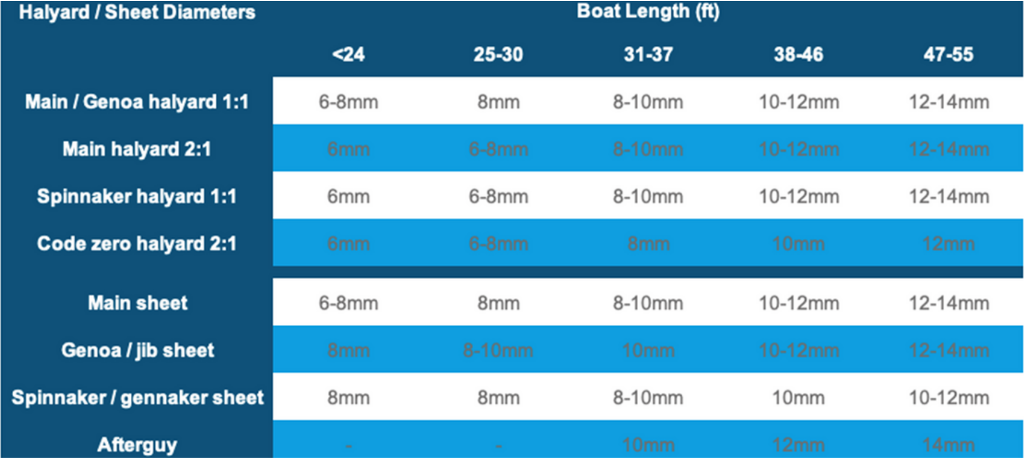Des draps
Les voiles des bateaux à voile doivent répondre à des critères de performance spécifiques. Elles doivent être faciles à manipuler et douces dans la main, tout en étant suffisamment rigides pour transmettre efficacement la charge des voiles à la propulsion du bateau. Ils sont constamment sur et hors des treuils et la résistance à la chaleur et à l'abrasion sont des priorités absolues pour leurs gaines tressées. En savoir plus...
Sail Sheets: Factors to Consider When Choosing
Material:
The material of the sail sheet is a critical consideration, as it directly impacts its performance, durability, and handling characteristics. Common materials include polyester, Dyneema®, and blended fibers, each offering different levels of strength, stretch, and abrasion resistance.
Diameter:
The diameter of the sail sheet affects its grip, handling, and strength. Thicker polyester sheets provide better, more comfortable handling and durability, while thinner, higher strength Dyneema® sheets offer reduced weight and performance. Consider the specific requirements of your sailing yacht and personal preferences when selecting the diameter. The table below provides a rough guide for the correct diameter for sheets on a mid-displacement monohull:

Stretch:
Minimizing stretch is essential for efficient sail control and responsiveness. Choose sail sheets with low stretch characteristics, particularly for high-performance sailing or racing, to ensure precise sail adjustments and optimal performance in varying wind conditions. Our rule-of-thumb and sensible cut-off between Polyester and Dyneema® sheets is 45ft. Under 45ft, Polyester can provide adequate strength and stiffness whereas above 45ft, regardless of whether you are cruising or racing, a Dyneema® core becomes a necessity to handle the loads above this boat size.
Grip:
The grip of the sail sheet determines how securely it can be held and handled in the sailors hand, or on a winch. Dinghy sheets are often softer and larger diameter to make them a more comfortable to grip in the hand for extended periods. Also Look for sheets with textured or coated surfaces that provide enhanced grip, especially when handling wet or slippery conditions. On larger boats, grip on the winch and abrasion resistance, for highly loaded sheets, become more important factors and specialist braided covers can be used to improve sheet performance and durability.
How Long Should My Sail Sheets Be?
The length of sail sheets depends on several factors, including the type of sail, rigging setup, and personal preferences. Here are some guidelines for determining the appropriate length:
Mainsail Sheets: For mainsail sheets, the length should be sufficient to allow easy handling and trimming while maintaining optimal sail control. Measure the distance from the sail's clew to the primary winch or cleat, adding extra length for adjustments and maneuvers. Due to the huge variety of mainsheet systems with different load points and purchases, there are no standard calculations for mainsheet length.
Jib/Genoa Sheets: Jib or genoa sheets should be long enough to reach the sail's clew with ample slack for tacking or gybing maneuvers. For a 100% jib we would normally recommend your Boat Length (Length Overall – LOA) for the sheet length and for larger genoas up to 150% LP we would recommend Boat length (LOA) x 1.5
Spinnaker and Gennaker Sheets: Spinnaker sheets should be long enough to allow for easy trimming and adjustments while flying the spinnaker. We recommend Boat length (LOA) x 1.9 for spinnaker sheets and Boat length (LOA) x 2.2 for gennaker sheets
What Splicing and Attachment Options Should I Choose for Sail Sheets?
1. Eye Splice: At the sail end of the sheet an eye splice creates a permanent loop at the end of the sail sheet, allowing for easy attachment to sail clews or hardware. This splice provides a secure and streamlined connection, minimizing bulk and friction when handling the sheet.
We would always recommend a spliced eye at the end of the sail sheet. The alternatives e.g. a bowline or even stopper knot, are bulky, unreliable and cause a potential snag hazard. A simple eye splice can be mastered by amateur sailors but is also relatively inexpensive even if spliced by a professional rigger, and the benefits far outweigh the costs.
2. Tapering: Most sheets require a double braid construction for grip in the sailors hand or around a winch. However, on more performance orientated boats the last few meters before the sail clew can be srtipped back to just the core material, with an single braid eye splice at the end. This reduces weight and windage. This method is particularly useful for light air spinnaker and gennaker sheets.
3. Hardware: The best method of securing sheets to the clew of the sail is a soft shackle. These are lightweight, secure fixing methods which will not damage the sail, deck, mast or rigging during manoeuvers. The only application to use a metal snap shackle is where the sheet is required to be released from the clew under load e.g. a traditional symmetrical spinnaker guy.
4. Whipped End: At the cockpit end of the sheet a simple whipping is a tried and tested method of maintaining a clean end. This involves wrapping a small twine around the rope end, securing the rope's fibers to prevent fraying or unraveling. While not technically a splice, whipping provides a simple and effective way to finish the end of the sheet, enhancing durability and longevity.
In conclusion, choosing the right sail sheets involves considering various factors such as material, length, splicing options, and compatible hardware. By understanding these key considerations and guidelines, sailors can select sail sheets that offer optimal performance, durability, and reliability on the water. Whether it's polyester, Dyneema®, or blended fibers, selecting the right material, length, and splicing technique ensures smooth handling and efficient sail control in any sailing condition. Pairing sail sheets with appropriate hardware further enhances safety, convenience, and performance, allowing sailors to enjoy their time on the water with confidence and ease.

To install this Web App in your iPhone/iPad press
![]() and then Add to Home Screen.
and then Add to Home Screen.


